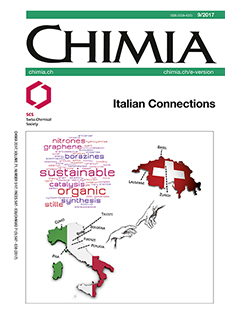Renaissance of an Old Topic: From Borazines to BN-doped Nanographenes
DOI:
https://doi.org/10.2533/chimia.2017.550Keywords:
2d bn-doped networks, Band gap, Bn-doped, Borazines, Graphene, Nanographene, PolyphenylenesAbstract
Graphene is one of the leading materials in today's science, but the lack of a band gap limits its application to replace semiconductors in optoelectronic devices. To overcome this limitation, the replacement of C=C bonds by isostructural and isoelectronic bonds is emerging as an effective strategy to open a band gap in monoatomic graphene layers. First prepared by Stock and Pohland in 1926, borazine is the isoelectronic and isostructural inorganic analogue of benzene, where the C=C bonds are replaced by B–N couples. The strong polarity of the BN bonds widens the molecular HOMO–LUMO gap, imparting strong UV-emission/absorption and electrical insulating properties. These properties make borazine a valuable molecular scaffold to be inserted as doping units in graphitic-based carbon materials to tailor a relevant band gap. It is with this objective that we became interested in the development of new synthetic organic methodologies to gain access to functionalized borazine derivatives. In particular, we have described the synthesis of borazine derivatives that, featuring aryl substituents at the B-centers bearing ortho-functionalities, are exceptionally stable against hydrolysis. Building on these structural motifs, we prepared hybrid BN-doped polyphenylene nanostructures featuring controlled doping patterns, both as dosage and orientation. Finally, exploiting the Friedel-Craft electrophilic aromatic substitution, we could develop the first rational synthesis of the first soluble hexa-peri-hexabenzoborazinocoronene and measured its optoelectronic properties, showing a widening of its gap compared to its full-carbon congener.Downloads
Published
2017-09-27
Issue
Section
Scientific Articles
License
Copyright (c) 2017 Swiss Chemical Society

This work is licensed under a Creative Commons Attribution-NonCommercial 4.0 International License.
How to Cite
[1]
Chimia 2017, 71, 550, DOI: 10.2533/chimia.2017.550.







